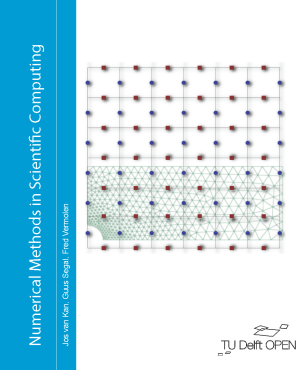Numerical Methods in Scientific Computing
Synopsis
This is a book about numerically solving partial differential equations occurring in technical and physical contexts and the authors have set themselves a more ambitious target than to just talk about the numerics. Their aim is to show the place of numerical solutions in the general modeling process and this must inevitably lead to considerations about modeling itself. Partial differential equations usually are a consequence of applying first principles to a technical or physical problem at hand. That means, that most of the time the physics also have to be taken into account especially for validation of the numerical solution obtained. This book aims especially at engineers and scientists who have ’real world’ problems. It will concern itself less with pesky mathematical detail. For the interested reader though, we have included sections on mathematical theory to provide the necessary mathematical background. Since this treatment had to be on the superficial side we have provided further reference to the literature where necessary.
Downloads
References
R.A. Adams. Sobolev Spaces. Academic Press, New York, 1975.
Robert A. Adams. Calculus, a complete course. Fifth Edition. Addison Wesley Longman, Toronto, 2003.
R. Aris. Vectors, Tensors and the Basic Equations of Fluid Mechanics. Prentice-Hall, Inc., Englewood Cliffs, N.J., 1962. Reprinted, Dover, New York, 1989.
J. Bear. Dynamics of Fluids in Porous Media. American Elsevier publishing company, New York, 1972.
E.K. Blum. Numerical Analysis and Computation: Theory and Practice. Addison-Wesley Publishing Company, Reading, Mass, 1972.
A.N. Brooks and T.J.R. Hughes. Stream-line upwind/Petrov Galerkin formulstion for convection dominated flows with particular emphasis on the incompressible Navier-Stokes equation. Comp. Meth. Appl. Mech. Eng., 32:199-259,1982. https://doi.org/10.1016/0045-7825(82)90071-8
R.L. Burden and J.D. Faires. Numerical analysis. Brooks/Cole, Pacific Grove,2001.[8] J.R. Cannon. The one-dimensional heat equation. Addison-Wesley Publishing company, Menlo park, California, U.S.A., 1984.
H.S. Carslaw and J.C. Jæger. Conduction of heat in solids, volume 2. Clarendon Press, Oxford, 1988.
S. Chen, B. Merriman, S. Osher, and P. Smereka. A simple level-set method for solving stefan problems. J. Comp. Phys., 135:8-29, 1997. https://doi.org/10.1006/jcph.1997.5721
Ph.G. Ciarlet. The Finite Element Method for Elliptic Problems. North-Holland, Amsterdam, 1978. https://doi.org/10.1115/1.3424474
R. Courant and D. Hilbert. Methods of Mathematical Physics, Vol. 2. Partial Differential Equations. Interscience, New York, 1989. https://doi.org/10.1002/9783527617234
J. Crank. Free and Moving Boundary Problems. Clarendon Press, Oxford, 1984.
E. Cuthill and J. McKee. Reducing the bandwidth of sparse symmetric matrices. In Proc. 24th Nat. Conf. Assoc. Comput. Mech., pages 1-69, New York, 1969. ACM publ. https://doi.org/10.1145/800195.805928
C. Cuvelier, A. Segal, and A.A. van Steenhoven. Finite Element Methods and Navier-Stokes Equations. Reidel Publishing Company, Dordrecht, Holland,1986. https://doi.org/10.1007/978-94-010-9333-0
L.C. Evans. Partial Differential Equations. American Mathematical Society, 2010. https://doi.org/10.1090/gsm/019
A. George and J.W.H. Liu. Computer Solution of Large Sparse Positive Definite Systems. Prentice-Hall, Engelwood Cliffs, New Jersey, (USA), 1981.
Wolfgang Hackbusch. Multi-grid methods and applications. Springer, Berlin,2003 (1986). https://doi.org/10.1007/978-3-662-02427-0
C.W. Hirt, A.A. Amsden, and J.L. Cook. An Arbitrary Lagrangian-Eulerian computing method for all flow speeds. Journal of Computational Physics,14:227-253, 1974. https://doi.org/10.1016/0021-9991(74)90051-5
I. Holand and K. Bell eds. Finite Element Methods in Stress Analysis. Tapir, 1969,Trondheim, Norway, 1969.
B.M. Irons and A. Razazaque. Expericience with the patch test for convergence of finite elements. In A.K. Aziz, editor, The mathemattical foundations of the finite element method with applications to partial differential equations, pages 557-587, New-York, 1972. Academic Press. https://doi.org/10.1016/B978-0-12-068650-6.50025-3
E. Kreyszig. Introductory Functional Analysis with Applications. Wiley, NewYork, 1989.
J.D. Lambert. Numerical methods in ordinary differential equations. John Wiley, Englewood Cliffs, 1991.
David C. Lay. Linear Algebra and its applications. Addison Wesley, New York,1993.
R.J. LeVeque. Numerical Methods for Conservation Laws. Birkhäuser, Basel, 1992. https://doi.org/10.1007/978-3-0348-8629-1
A.R. Mitchell and D.F. Griffiths. The Finite Difference Method in Partial Differential Equations. Wiley, Chichester, 1994.
A.R. Mitchell and R. Wait. The finite element method in partial differential equations. Wiley, Chichester, 1977.
W.D. Murray and F. Landis. Numerical and machine solutions of transient heat-conduction problems involving melting or freezing. Trans. ASME (C) J.Heat Transfer, 81:106-112, 1959. https://doi.org/10.1115/1.4008149
S. Osher and J.A. Sethian. Fronts propagating with curvature-dependent speed: Algorithms based on hamilton-jacobi formulations. Journal of Computational Physics, 79:12-49, 1988. https://doi.org/10.1016/0021-9991(88)90002-2
M.H. Protter and H.F. Weinberger. Maximum Principles in Differential Equations. Prentice-Hall, Englewood Cliffs, 1967.
J.N. Reddy. An introduction to the finite element method. McGraw-Hill, New York, 1984.
P.P. Silvester and R.L. Ferrari. Finite elements for electrical engineers. Cambridge University Press, Cambridge, 1983.
J. Smoller. Shock Waves and Reaction-Diffusion Equations. Springer, New York,1983. https://doi.org/10.1007/978-1-4684-0152-3
J. Stefan. Über die Theorie der Eisbildung, insbesondere über die Eisbildungim Polarmeere. Annalen der Physik und Chemie, 42:269-286, 1891. https://doi.org/10.1002/andp.18912780206
James Stewart. Calculus. Fifth Edition. Brooks/Cole, New York, 2002.
G. Strang.Linear Algebra and its Applications, (third edition). Harcourt Brace Jovanovich, San Diego, 1988.
G. Strang and G.J. Fix.An Analysis of the Finite Element Method. Prentice Hall Inc., Englewood Clifts, New Jersey, 1973.
P.K. Sweby. High resolution schemes using flux-limiters for hyperbolic conservation laws. SIAM J. Num. Anal., 21:995-1011, 1984. https://doi.org/10.1137/0721062
R. Temam. Navier-Stokes Equations. North-Holland, Amsterdam, 1985.
U. Trottenberg, C.W. Oosterlee, and A. Schüller. Multigrid. Academic Press,2001.
H.A. van der Vorst. Iterative Krylov Methods for Large Linear Systems. Cambridge University Press, Cambridge, UK, 2003. https://doi.org/10.1017/CBO9780511615115
R.S. Varga. Matrix Iterative Analysis. Prentice-Hall, Englewood Cliffs, N.J.,1962.
F. Vermolen and K. Vuik. A numerical method to compute the dissolution of second phases in ternary alloys. J. Comp. Appl. Math., 93:123-143, 1998. https://doi.org/10.1016/S0377-0427(98)00076-4
A. Visintin. Models of phase transitions, Progress in nonlinear differential equations and their applications, volume 28. Birkhäuser, Boston, 1996.
C. Vuik. The Solution of a One-Dimensional Stefan Problem. CWI-tract 90. CWI, Amsterdam, 1993.
C. Vuik. Some historical notes about the stefan problem. Reports of the Faculty of Technical Mathematics and Informatics 93-07, Delft, 1993.
H. Weber. Die partiellen Differential-Gleichungen der Mathematischen Physik. Vieweg, Braunschweig, 1901.
Pieter Wesseling. An introduction to Multigrid Methods. John Wiley & Sons,Ltd, 1992. Corrected reprint. R.T. Edwards Inc., Philadelphia, 2004.
K. Yosida. Functional Analysis. Springer Verlag, Berlin, 1971. https://doi.org/10.1007/978-3-662-00781-5
O.C. Zienkewicz. Finite element method in Engineering Science. Mc Graw-Hill, 1971.




